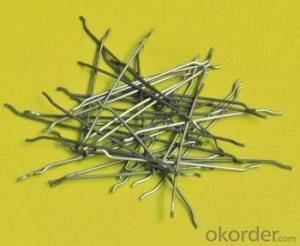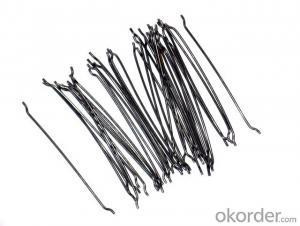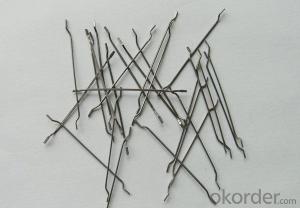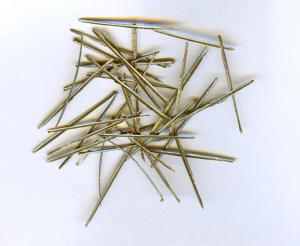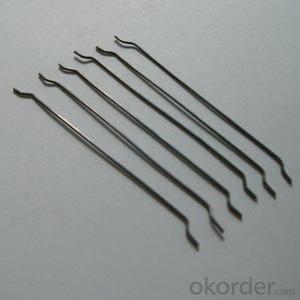Melt Extract Stainless Steel Fiber - Copper Coated Steel Fiber by CNBM International
- Loading Port:
- Tianjin
- Payment Terms:
- TT OR LC
- Min Order Qty:
- 1000 kg
- Supply Capability:
- 30000 kg/month
OKorder Service Pledge
Quality Product, Order Online Tracking, Timely Delivery
OKorder Financial Service
Credit Rating, Credit Services, Credit Purchasing
You Might Also Like
Quick Details
Place of Origin: Jiangsu, China (Mainland)
Model Number: HT-ST
Material: Steel
Specifications
| Diameter | 0.5mm, 0.6mm, 0.75 mm, 0.8mm, 0.9mm | ||
| Length | 30mm, 35mm, 50mm, 60mm | ||
| Aspect Ratio | 60, 65,80 | ||
| Tensile strength | 1200 MPa | ||
| Type | Cold drawn Steel Fiber | ||
| End | Hooked-end Steel Fiber | ||
| Glued/Loose | Glued Steel Fiber | ||
| Bending Angle | 45°(min.30°) | ||
| Usage & Performance | Floor:Trafficked areas and Industrial floors | ||
| Shotcrete :Slope stabilization and Final lining | |||
| Precast concrete:Pipe and Railway sleepers | |||
| Packing | Standard Export Pallet Packing | Bag Packing | 20 kg/Bag,50 bags/Pallet |
| Bulk Packing | 1,000kg/ Bulk Bag | ||
| Loading Quantity | 20’GP | 20-25 Tonne/Tonnes | |
| 40’GP | 25-27 Tonne/Tonnes | ||
| 40’HQ | 25-27 Tonne/Tonnes | ||
| MOQ | 1 kg for trial order | ||
| Supply Ability | 10,000 Tonne/Tonnes per Year | ||
| Payment Terms | T/T or L/C at sight | ||
| Delivery Time | Within 15 days after receiving deposit or original L/C at sight | ||
| Certification | ISO9001:2000, CE, | ||
Picture

Steel fiber


FAQ
certificated: ISO 9001
Technical advantages of Daye steel fiber:
A. Improve mechanical performance of concrete
B. Provide uniform distribution throughout concrete with excellent mixing
C. No balling or caking by adopt correct mixing method
D. Reduce concrete volume
E.Save construction time and cost
F.Reduce excavation volume
G.Available for jointless floor.
- Q: How does melt extract stainless steel fiber affect the crack propagation in concrete?
- Melt extract stainless steel fiber can effectively enhance the crack resistance and reduce crack propagation in concrete. The fibers act as reinforcement, providing additional strength and ductility to the concrete matrix. When cracks form, the fibers help to distribute the stress and prevent crack propagation by bridging the crack surfaces. This reinforcement mechanism improves the overall durability and performance of the concrete by minimizing crack width and preventing further crack development.
- Q: Is melt extract stainless steel fiber compatible with all types of aggregate?
- No, melt extract stainless steel fiber may not be compatible with all types of aggregate. The compatibility depends on various factors such as the size, shape, and composition of the aggregate, as well as the specific application requirements. It is important to consider consulting with experts or conducting tests to determine the compatibility before using melt extract stainless steel fiber with a particular type of aggregate.
- Q: Can melt extract stainless steel fiber be used in architectural concrete applications?
- Yes, melt extract stainless steel fiber can be used in architectural concrete applications. Stainless steel fibers are often added to concrete mixtures to increase its strength, durability, and resistance to cracking. The melt extract stainless steel fibers are particularly effective in architectural concrete applications due to their high tensile strength and corrosion resistance. These fibers can help to reinforce the concrete, improve its structural integrity, and provide additional protection against potential damage from environmental factors or heavy loads. Moreover, the use of stainless steel fibers in architectural concrete can also enhance the aesthetic appearance of the finished product, as they can be easily polished to create a smooth and shiny surface. Overall, melt extract stainless steel fibers are a suitable choice for architectural concrete applications, offering both functional and aesthetic benefits.
- Q: What is the effect of melt extract stainless steel fiber on the drying shrinkage of shotcrete?
- The use of melt extract stainless steel fiber in shotcrete can have a significant effect on the drying shrinkage of the material. Stainless steel fibers are known for their high tensile strength and resistance to corrosion, making them an ideal reinforcement material for shotcrete. When added to shotcrete mixtures, the stainless steel fibers help to distribute the shrinkage stresses throughout the material, reducing the overall drying shrinkage. This is due to the fibers acting as a reinforcement, providing additional strength and stability to the shotcrete. The presence of stainless steel fibers in shotcrete also helps to improve the overall durability and crack resistance of the material. This is particularly important in applications where shotcrete is exposed to harsh environmental conditions or subjected to heavy loads. Additionally, the use of stainless steel fibers can reduce the formation of plastic shrinkage cracks during the curing process. These cracks can occur due to the rapid evaporation of moisture from the shotcrete surface, leading to shrinkage and subsequent cracking. By reinforcing the shotcrete with stainless steel fibers, the material becomes more resistant to cracking and maintains its structural integrity. Overall, the addition of melt extract stainless steel fiber to shotcrete can greatly reduce the drying shrinkage of the material, improve its durability, and enhance its crack resistance. This makes it a valuable reinforcement option for shotcrete applications in various construction projects.
- Q: What is the effect of melt extract stainless steel fiber on the abrasion resistance of concrete?
- The abrasion resistance of concrete is significantly improved when melt extract stainless steel fiber is added. Stainless steel fibers are known for their high tensile strength, corrosion resistance, and durability. When they are mixed into the concrete, they provide reinforcement and enhance its overall mechanical properties. The melt extract process ensures that the stainless steel fibers are consistently produced with a specific diameter and length. As a result, they are dispersed evenly throughout the concrete matrix. This even distribution creates a three-dimensional reinforcement network that effectively increases the concrete's resistance to abrasion. The presence of stainless steel fibers in concrete strengthens its ability to withstand wear and tear caused by frictional forces. This is particularly advantageous in areas with heavy traffic, such as industrial floors, parking lots, and roadways. These areas experience heavy loads, vehicle movement, and continuous foot traffic. Additionally, stainless steel fibers enhance the impact resistance of concrete. This reduces the likelihood of surface spalling or cracking due to external forces. As a result, the concrete structure requires less maintenance and repair over its lifespan. In conclusion, incorporating melt extract stainless steel fiber into concrete significantly enhances its abrasion resistance. It improves the concrete's ability to withstand wear and tear, extends its lifespan, and reduces the need for frequent maintenance and repair.
- Q: Can melt extract stainless steel fiber be used in the construction of railway tunnels?
- Yes, melt extract stainless steel fiber can be used in the construction of railway tunnels. Stainless steel fiber is known for its high strength, durability, and resistance to corrosion, which makes it suitable for various construction applications, including railway tunnels. The use of stainless steel fiber in tunnel construction helps to enhance the overall structural integrity and longevity of the tunnels. It can reinforce the concrete used in the tunnel lining, providing increased resistance to cracking and improved load-bearing capacity. Additionally, stainless steel fibers can also offer enhanced fire resistance properties, which is crucial for ensuring the safety of railway tunnels. Therefore, melt extract stainless steel fiber is a suitable material to be used in the construction of railway tunnels.
- Q: Can melt extract stainless steel fiber be used in combination with other types of reinforcement?
- Yes, melt extract stainless steel fiber can be used in combination with other types of reinforcement. Stainless steel fiber is commonly used as a secondary reinforcement in concrete to improve its mechanical properties, such as ductility, toughness, and resistance to cracking. It can be combined with other types of reinforcement, such as steel rebars or synthetic fibers, to enhance the overall performance of the concrete structure. The combination of different types of reinforcement can provide a synergistic effect, resulting in improved strength and durability. However, it is important to consider the compatibility and compatibility of the different reinforcement materials, as well as the design and construction requirements, to ensure proper integration and performance.
- Q: How does melt extract stainless steel fiber improve the bond strength of concrete?
- Melt extract stainless steel fiber improves the bond strength of concrete by enhancing the interfacial bond between the fiber and the surrounding matrix. The high tensile strength and aspect ratio of the stainless steel fibers create mechanical interlocking with the concrete, effectively increasing the bond between the fiber and the matrix. This improved bond strength helps to prevent cracking and enhance the overall structural integrity of the concrete.
- Q: What is the effect of melt extract stainless steel fiber on the flexural toughness of shotcrete?
- The effect of melt extract stainless steel fiber on the flexural toughness of shotcrete is an increase in the overall toughness and crack resistance of the material. The stainless steel fibers reinforce the shotcrete, preventing the propagation of cracks and enhancing its ability to withstand bending and flexural stresses. This results in improved durability and structural integrity of the shotcrete, making it more suitable for applications where flexural toughness is important, such as tunnel linings or retaining walls.
- Q: Can melt extract stainless steel fiber be used in high-performance concrete?
- Yes, melt extract stainless steel fiber can indeed be used in high-performance concrete. Stainless steel fibers are commonly used as reinforcement in concrete to enhance its mechanical properties and durability. The melt extract stainless steel fibers are made by melting stainless steel and then drawing it into fine fibers. These fibers are typically added to concrete mixtures in small quantities to improve its tensile strength, flexural strength, and resistance to cracking. The use of melt extract stainless steel fibers in high-performance concrete can significantly enhance its performance. The fibers act as reinforcement, providing additional strength and preventing the propagation of cracks. This is especially important in high-performance concrete, which is designed to have superior mechanical properties and withstand harsh conditions. The addition of melt extract stainless steel fibers can improve the concrete's resistance to impact, fatigue, and fire. It also helps to reduce shrinkage and cracking, thus increasing the service life of the concrete structure. Moreover, stainless steel fibers are corrosion-resistant, which is particularly beneficial in environments where the concrete is exposed to aggressive chemicals or moisture. In conclusion, melt extract stainless steel fiber is a suitable and effective reinforcement material for high-performance concrete. It improves the concrete's mechanical properties, durability, and resistance to cracking, thereby enhancing the overall performance of the concrete structure.
Send your message to us
Melt Extract Stainless Steel Fiber - Copper Coated Steel Fiber by CNBM International
- Loading Port:
- Tianjin
- Payment Terms:
- TT OR LC
- Min Order Qty:
- 1000 kg
- Supply Capability:
- 30000 kg/month
OKorder Service Pledge
Quality Product, Order Online Tracking, Timely Delivery
OKorder Financial Service
Credit Rating, Credit Services, Credit Purchasing
Similar products
Hot products
Hot Searches
Related keywords









